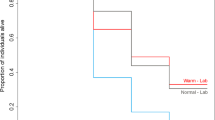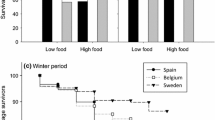Abstract
Using field and laboratory observations and experiments over 3 years, I investigated whether reproductive trade-offs shape individual life histories in two natural populations of the water strider, Aquarius remigis, in which univoltine and bivoltine life cycles coexist. Both later eclosion dates and food shortages, even after adult eclosion, induced diapause in females, thus deferring reproduction to the following spring. Adult body size was positively affected by food availability during juvenile development. Higher food levels also increased the reproductive output of females, but not their longevity or oviposition period. When compared to spring breeders (univoltine life cycle), direct (summer) breeders (bivoltine life cycle) experienced reduced lifetime egg numbers and longevity, as well as reduced survivorship of their second-summer-generation offspring; these reproductive costs offset, at least in part, the advantage in non-decreasing populations of having two generations per year. Fecundity was correlated with body size, and among summer-generation females direct breeders were larger than non-breeders. The time remaining before the onset of winter and/or the time since adult eclosion augmented cumulative energy uptake, and consequently the lipid reserves and winter survival probability of non-breeding (diapausing) summer adults approaching hibernation. Overwintered spring reproductives died at faster rates than non-reproductive summer individuals despite greater food availability in spring, indicating a mortality cost of reproduction. Body length correlated with absolute and not with proportional lipid content but showed no consistent relationship with survivorship in the field. These results are in agreement with current theory on the evolution of insect voltinism patterns, and further indicate high degrees of life history flexibility (phenotypic plasticity) in the study populations in response to variable environmental factors (notably photoperiod and food availability). This may be related to their location in a geographic transition zone from uni- to bivoltine life cycles.
Similar content being viewed by others
References
Andersen NM (1990) Phylogeny and taxonomy of water striders, genus Aquarius Schellenberg (Insecta, Heteroptera, Gerridae), with a new species from Australia. Stcenstrupia 16: 37–81
Beck SD (1980) Insect photoperiodism. Academic Press, New York
Behrens W (1985) Environmental aspects of insect dormancy. In: Hofmann KH (ed) Environmental physiology and biochemistry of insects. Springer, Heidelberg, pp 67–94
Bell G (1980) The costs of reproduction and their consequences. Am Nat 116: 45–76
Blanckenhorn WU (1990) Fitness consequences of foraging success and life history tactics in water striders, Gerris remigis. Ph.D. Dissertation, State University of New York at Albany, New York, USA
Blanckenhorn WU (1991a) Voltinism differences in adjacent water strider populations: phenotypic plasticity or heritable responses to stream temperature? Evolution 45: 1520–1526
Blanckenhorn WU (1991b) Fitness consequences of food-based territoriality in water striders, Gerris remigis. Anim Behav 42: 147–149
Blanckenhorn WU (1991c) Foraging in groups of water striders: effects of variability in handling time and prey arrivals. Behav Ecol Sociobiol 28: 221–226
Cohen D (1970) A theoretical model for the optimal timing of diapause. Am Nat 104: 389–400
Danilevsky AS (1965) Photoperiodism and seasonal development in insects. Oliver and Boyd, London
Danks HV (1987) Insect dormancy: an ecological perspective. Biological Survey of Canada, Ottawa
Fairbairn DJ (1985) Comparative ecology of Gerris remigis in two habitats: a paradox of habitat choice. Can J Zool 6: 2594–2603
Fairbairn DJ (1986) Does alary dimorphism imply dispersal dimorphism in the water strider, Gerris remigis? Ecol Entomol 11: 355–368
Fairbairn DJ (1988a) Adaptive significance of wing dimorphism in the absence of dispersal: a comparative study of wing morphs in the water strider Gerris remigis. Ecol Entomol 13: 273–281
Fairbairn DJ (1988b) Sexual selection for homogamy in the Gerridae: an extension of Ridley's comparative approach. Evolution 42: 1212–1222
Firko M (1986) Comparative life history evolution in the water strider Gerris remigis. Ph.D. Dissertation, University of Pennsylvania, Philadelphia, Pennsylvania, USA
Galbraith DF, Fernando CH (1977) The life history of Gerris remigis in a small stream in southern Ontario. Can Entomol 109: 221–228
Hauser R (1982) Untersuchungen zum Voltinismus und Flügelpolymorphismus beim Wasserläufer Gerris lacustris. Rev Suisse Zool 89: 903–917
Hauser R (1985) Ein Diapausesekret bei Wasserläufern (Hempitera, Gerridae). Mitt Schweiz Entomol Ges 58: 511–525
Istock CA (1981) Natural selection and life history variation: theory plus lessons from a mosquito: In: Denno F, Dingle H (eds) Insect life history patterns. Springer, Heidelberg, pp 113–127
Köpfli R, Hauser R, Zimmermann M (1987) Diapuusedetermination bei Wasserläufern (Hemiptera, Gerridae). Rev Suisse Zool 94: 533–543
Kaitala A (1987) Dynamic life-history strategy of the water strider Gerris thoracicus as an adaptation to food and habitat variation. Oikos 48: 125–131
Kaitala A (1988) Wing muscle dimorphism: two reproductive pathways of the water strider Gerris thoracius in relation to habitat instability. Oikos 53: 222–228
Lee RF, Polhemus DT, Cheng L (1975) Lipids of the water strider Gerris remigis (Heteroptera: Gerridae): seasonal and developmental variations. Comp Biochem Physiol 51B:451–456
Lewontin RC (1965) Selection for colonizing ability. In: Baker GA, Stebbins GL (eds) The function of colonizing species. Academic Press, New York, pp 77–91
Ludwig D, Rowe L (1990) Life-history strategies for energy gain and predator avoidance under time constraints. Am Nat 135:686–707
Masaki S (1967) Geographic variation and climatic adaptation in a field cricket. Evolution 21: 725–741
Masaki S (1972) Climatic adaptation and photoperiodic response in the band-legged ground cricket. Evolution 26:587–600
Matthey W (1974) Contribution à l'écologie de Gerris remigis sur les deux étangs des Montagnes Rocheuses. Mitt Schweiz Entomol Ges 47:85–95
Mousseau TA, Roff DA (1989) Adaptation to seasonality in a cricket: patterns of phenotypic and genotypic variation in body size and diapause expression along a cline in season length. Evolution 43:1483–1496
Partridge L, Harvey PH (1988) The ecological context of life history evolution. Science 241:1449–1455
Philippi T, Seger J (1989) Hedging one's evolutionary bets, revisited. Trends Ecol Evol 4:41–44
Preziosi RF, Fairbairn DJ (1992) Genetic population structure and levels of gene flow in the stream dwelling water strider, Aquarius remigis (Heteroptera: Gerridae). Evolution 46:430–444
Reiss MJ (1989) The allometry of growth and reproduction. Cambridge University Press, Cambridge
Roff DA (1980) Optimizing development time in a seasonal environment: the ‘ups and downs’ of clinal variation. Oecologia 45:202–208
Roff DA (1983) Phenological adaptation in a seasonal environment: a theoretical perspective. In: Brown VK, Hodek I (eds) Diapause and life cycle strategies in insects. Junk, The Hague, pp 253–270
Rowe L, Ludwig D (1991) Time constraints and variation in size and timing of metamorphosis in complex life cycles. Ecology 72:413–427
Rowe L, Scudder GGE (1990) Reproductive rate and longevity in the water strider, Gerris buenoi. Can J Zool 68:99–402
Rubenstein D (1984) Resource acquisition and alternative mating strategies in water striders. Am Zool 24:345–353
Rubenstein D (1989) Sperm competition in the water strider, Gerris remigis. Anim Behav 38:631–636
Spence JR (1980) Density estimation of water-striders (Heteroptera: Gerridae). Freshwater Biol 10:563–570
Spence JR (1986) Relative impacts of mortality factors in field populations of the water strider Gerris buenoi (Heteroptera: Gerridae). Oecologia 70:68–76
Spence JR (1989) The habitat templet and life history strategies of pondskaters: reproductive potential, phenology, and wing dimorphism. Can J Zool 67:2432–2447
Stearns SC (1976) Life history tactics: a review of ideas. Q Rev Biol 51:3–47
Tauber CA, Tauber MJ (1986) Ecophysiological responses in life-history evolution: evidence for their importance in a geographically widespread insect species complex. Can J Zool 64:875–884
Tauber MJ, Tauber CA, Masaki S (1986) Seasonal adaptations of insects. Oxford University Press, Oxford
Taylor F (1980) Optimal switching to diapause in relation to onset of winter. Theor Pop Biol 18:125–133
Vepsäläinen K (1971) The role of gradually changing daylength in determination of wing length, alary dimorphism, and diapause in a Gerris odontogaster population in South Finland. Ann Acad Sci Fenn A IV 183:1–25
Vepsäläinen K (1974) Determination of wing length and diapause in water striders. Hereditas 77:163–176
Vepsäläinen K (1978) Wing dimorphism and diapause in Gerris: determination and adaptive significance. In: Dingle H (ed) Evolution of insect migration and diapause. Springer, Heidelberg, pp 218–253
Vepsäläinen K, Nummelin M (1985) Female territoriality in the waterstriders Gerris najas and G. cinereus. Ann Zool Fenn 22:433–439
Wilbur HM, Tinkle DW, Collins JP (1974) Environmental certainty, trophic level, and resource availability in life history evolution. Am Nat 108:805–816
Wilcox RS (1984) Male copulatory guarding enhances female foraging in a water strider. Behav Ecol Sociobiol 15:171–174
Wilcox RS, Ruckdeschel T (1982) Food threshold territoriality in a water strider (Gerris remigis). Behav Ecol Sociobiol 11:85–90
Williams GC (1966) Natural selection, the cost of reproduction, and a refinement of Lack's principle. Am Nat 100:687–690
Wootton RJ (1979) Energy cost of egg production and environmental determinants of fecundity in teleost fishes. Symp Zool Soc London 44:33–159
Zera A (1981) Genetic structure of two species of water striders with differing degrees of winglessness. Evolution 35:218–225
Zimmermann M, Hauser R, Hüsler J (1982) Schätzung der stadienspezifischen Dichten und Ueberlebensraten in einer Larvenpopulation von Gerris lacustris (Hemiptera, Gerridae). Rev Suisse Zool 89:941–955
Author information
Authors and Affiliations
Rights and permissions
About this article
Cite this article
Blanckenhorn, W.U. Fitness consequences of alternative life histories in water striders, Aquarius remigis (Heteroptera: Gerridae). Oecologia 97, 354–365 (1994). https://doi.org/10.1007/BF00317325
Received:
Accepted:
Issue Date:
DOI: https://doi.org/10.1007/BF00317325




